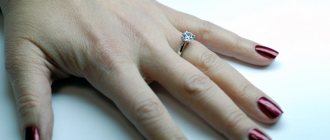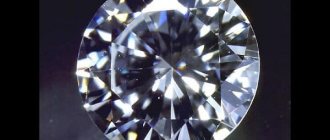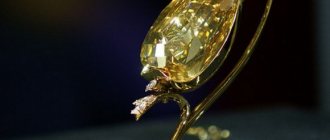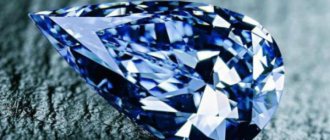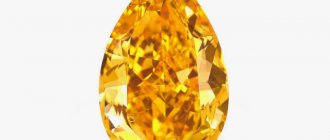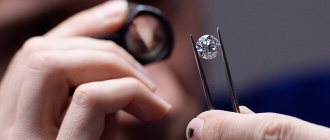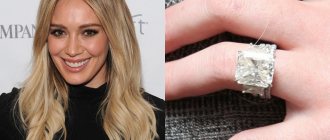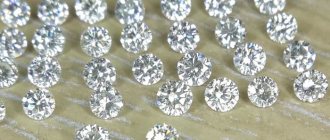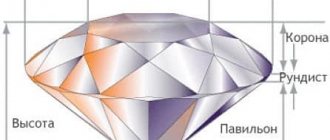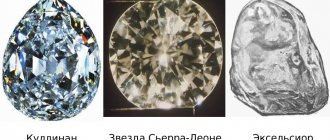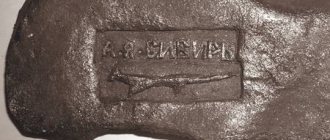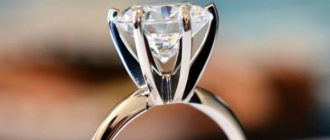- Home page
Unlike a diamond that plays with its facets, a natural diamond does not look as presentable. The jeweler receives a nondescript-looking sample with an irregular shape for processing. The mineral is dull, its surface is covered with a kind of “crust”, riddled with cracks. But even in this state, the diamond is already able to reflect light and play with its edges. The jeweler’s task is to cut the stone so that its individual features in the form of voids and cracks become its additional advantages. A diamond in its natural form will be of interest to collectors and people who want to receive an exclusively cut diamond. For an ordinary person, it is possible to purchase a diamond when traveling on “diamond tours”, where stones are purchased directly at mining sites. In order to avoid becoming a victim of deception or to correctly evaluate a specimen that has fallen into your hands, it is worth understanding the signs of a genuine diamond.
Types and differences of analogues
Due to the high cost of diamonds, jewelers and manufacturers of electronics and equipment are looking for ways to reduce production costs without sacrificing quality. This is how diamond analogues appeared, making it possible to imitate the shine, hardness and aesthetic component of natural stone.
- Moissanite is a silicon carbide. In terms of its ability to sparkle, moissanite is even 25% ahead of diamond. The stone also refracts colors perfectly and has similar thermal conductivity. Moissanite is inferior only in hardness - 9.25 on the Mohs scale.
- Cubic zirconia or cubic zirconium. Its low cost made it an ideal option for inexpensive jewelry products. The characteristics are significantly inferior to diamond and moissanite.
Also, rhinestones (the cheapest glass option), colorless sapphires, rutile, fabulite, yttrium-aluminum garnet, gallium-gadolinium garnet, zircon, and scheelite can be used as substitutes.
In most cases, the desire to confirm the authenticity of a stone applies to diamonds. When purchasing a product or inheriting jewelry, you want to understand how valuable the purchase is. A diamond is a cut diamond, their properties will be identical, except for trying to see the text through the stone. The cut will prevent you from seeing anything through the stone due to the refraction of light within. Other verification methods are suitable in both cases.
What is imitation diamond?
A diamond simulant is a stone that resembles a real diamond and shares some of its characteristics. Although simulants are used as diamond imitations, they have a different chemical structure from real diamonds.
There are a number of gemstones that resemble diamonds in appearance, and some are even close in terms of physical properties. Some mimics occur naturally, while others are created artificially.
Stones that are commonly used as diamonds are cubic zirconia and moissanite. Other popular substitutes are white sapphire, zircon and rutile. Spinel, synthetic garnet and rock crystal are also used as diamond substitutes.
It should be noted that fake diamonds are different from synthetic (or lab-grown) diamonds. Synthetics are artificial, but they have the same chemical composition as natural diamonds.
Simulants, on the other hand, are not made of carbon and have properties that are different from diamonds. Some other names used to refer to diamond simulants are: simulated, fake, artificial.
Imitations vs. Synthetic Diamonds: What's the Difference?
Many people confuse synthetic diamonds with imitation diamonds. However, the two terms have different meanings.
Synthetic diamonds are actually real diamonds that are created in a laboratory.
Unlike simulants, these stones have the same chemical composition as natural diamonds, and sometimes, synthetics have superior physical properties.
Synthetic diamonds are also referred to as lab-grown, lab-created, cultured, or man-made.
People often assume that just because a diamond is said to be synthetic or lab-grown, that it is actually fake.
Although many diamond substitutes are also lab-created, whether a stone is fake is determined by its chemical structure, not the way it is made.
The only way synthetic diamonds differ from natural diamonds is that synthetics are created artificially.
Verification methods
Not only diamond is colorless and transparent. There are other stones with similar characteristics. To understand that this is a diamond specimen, you can use both everyday verification methods and expert evaluation options. The ideal option is a comparison with a standard, but either jewelers and collectors or gemological laboratories can afford this. In other cases, it is worth relying on knowledge about the qualities of diamond and its physical and chemical properties. Visual inspection and hardware testing in the laboratory are also possible.
Natural qualities
Diamond has a unique intensity of shine; it sparkles brightly, regardless of the type of light source. The stone has ideal transparency, but to come across an absolutely colorless mineral is a great success.
The shade of a diamond depends on the concentration of impurities, inclusions, as well as the intensity of exposure to radiation. One stone can have several shades at once. Most often in nature, stones of white and yellowish colors are found.
Gray milky and black color is a sign of a technical diamond. The board, ballas and carbonado units are also painted. Of all mined diamonds, aggregates account for 80% of the total volume.
It is impossible to find two identical diamond samples in nature; stones are as unique as fingerprints.
Hardness
Diamond has the highest rating on the Mohs scale. This is the hardest material. Diamond has the highest abrasion resistance. This is the reason for testing the stone with sharp objects and abrasives. A diamond can only be scratched with the same stone. Natural diamond can cut glass.
But the proposal to hit the diamond with a heavy hand may turn out to be dubious. In different directions of the crystal, its hardness varies. If you hit it too hard, the diamond will split along planes parallel to the edges of a regular octahedron. The technology of sawing, grinding and cutting rough diamonds is based on this property.
If you do not plan to cut the fragments in the future, it is better to move the hammer away from the stone.
Thermal conductivity
A diamond can be verified for authenticity by its characteristic feature of thermal conductivity. It is suggested to breathe on the sample: if the stone is real, then there will be no condensation from breathing on it. Also, it will take a long time to warm a diamond in your hands. It is worth remembering that you can only distinguish a diamond from a glass fake or a synthetic analogue. If you hold a natural gem with a colorless color, it may have characteristics similar to a diamond.
The thermal conductivity of diamond is 0.9-2.3 kW/(m*K), this is the highest among known solids. That is why it is used as a semiconductor. The efficiency threshold of silicon analogues cannot exceed 100°C.
Due to the high thermal conductivity of diamond, for example, weapons cool quickly. The thermal conductivity of diamond [0 35 cal / (cm-sec - C)] is higher than the thermal conductivity of hard alloys [0 05 - 0 19 cal / (cm-sec - C) 1 and high-speed steel [0 05 - 0 07 cal / (cm-sec — C) 1. This property allows heat to be removed from the cutter in a diamond tool faster than in a carbide tool.
Fat absorption
This property of diamonds is used, among other things, when raw materials are supplied for processing. Diamonds stick if you first drop regular vegetable oil on them and then press them to the surface of the glass. Counterfeits and other minerals do not react this way, so the method is considered 100%.
Another option for checking the authenticity of a stone is to use a felt-tip pen with thick ink. If you draw a line across the surface of a fake, the ink will fall out in drops, but on a real diamond the line will be smooth.
Interaction with different environments
A diamond is visible in water, it will not disappear. The density of water is less than that of a diamond; the refractive index of light will also be inferior to a gem.
- Density: 0.10 g/cm³ for water versus 3.47 - 3.55 g/cm³ for diamond.
- Light refractive index: 1.33 (H2O) and 2.42 (diamond).
Based on the numbers, it can be seen that hiding a stone in a bottle or glass of water will be problematic in reality. But water can establish the authenticity of a stone. If you drop water on it and try to puncture the drop, it will remain intact, but with fakes it will spread.
Dust will also help to reveal a fake diamond. If you place a stone near small particles, the dust will be attracted to the fake, but the real diamond will remain clean.
When exposed to high temperatures of 800-1000°C, diamond can return to the graphite state. That is why they must be stored in a fireproof safe or in a safe deposit box. Vacuum storage will help increase the critical interval to 2000 °C.
Diamond is inert towards solutions of acids and alkalis, but is quite easily etched at 600-800°C in molten alkalis, salts of oxygen acids and metals. But if you put a fake in hydrochloric acid, it can change color, turn brown or dissolve.
If you run aluminum over a ground sample, a “graphite” trace will remain on the diamond. Important: such a mark is difficult to remove later, so it is better to experiment on an inconspicuous area.
Visual
If it is not possible to obtain the opinion of an expert gemologist, then it is worth using a magnifying glass with X10 magnification or a microscope. It is ideal if you have a guaranteed genuine diamond as a standard for comparison.
- Natural stone will always have small defects - cracks, inclusions. Flawless stones are very expensive. In a diamond with an average or “democratic” price, the absence of “imperfections” should be alarming.
- Diamond's ability to reflect light and sparkle is present even in rough stones. A true diamond, when processed, shines on all sides, not just on the edges.
- Clear and even edges are another visual sign of a genuine stone. Even if it was worn for a very long time, the edges will not be erased. The girdle of the diamond is rough and matte, the smooth and transparent girdle is the privilege of the “glasses”.
To check the quality of a stone “by eye” requires good practical experience. If you don't have one, it's wise to enlist the help of a professional appraiser or jeweler who is not an interested party.
Types of imitation diamonds - “fake” or honest substitute?
Several types of fakes or imitation diamonds should be distinguished:
- themselves , forgeries, imitations - materials that are not diamonds, but are passed off as one. Until the 19th and 20th centuries, glass or other stones were usually passed off as diamonds. At the end of the 19th and especially in the 20th century, synthetic materials similar in their physical and chemical properties to diamond appeared. In our opinion, a diamond can be considered fake if it is passed off to the buyer as a real diamond, that is, they are deceived. If the buyer knows that the jewelry is made to look like a diamond, then it is more appropriate to use the term imitation.
- Synthesized or artificial diamonds are diamonds, but they are created (“grown”) using special industrial technologies. They cannot be called fake or imitations, since their properties are diamonds. However, the buyer must know the origin of his diamond, since artificial diamonds are valued much lower than natural ones created by nature.
- Improved or refined diamonds are stones that have been processed (except for cutting and polishing) to improve their marketability and increase their price. Such stones are real diamonds, but their value may be lower and the buyer should be aware of this.
Who can spot a fake diamond?
Next, we will talk in more detail about methods for identifying imitation diamonds and polished diamonds. However, it should be understood that the methods listed below should be used by professional jewelers, appraisers and experts.
At home, without special equipment and skills, it is almost impossible to distinguish a good imitation. This is due to the fact that many artificial materials have significant similarity in their properties to the properties of diamonds. In addition, there is mainly a need to test diamonds that are part of a piece of jewelry and are relatively small, which makes identification even more difficult.
Therefore, you should contact professional jewelers or gemologists to check. Such a check will not cost much, and confidence in the quality of the product will add to your pleasure and joy from owning it.
Comparison of natural diamonds and their imitations.
When comparing, you should focus on how they are similar and different in terms of their most important characteristics: clarity, durability, luster, color and price.
Purity
A diamond's clarity is a measure of how visible flaws are in the stone, as well as how prominently they are located. Naturally, real diamonds and other precious stones have such flaws.
The most common imitation diamonds have a higher clarity than natural diamonds. This is because these fakes are usually created in a laboratory in a process designed to reduce as many inclusions (flaws) in the stone as possible.
Some man-made diamonds are cubic zirconia, most are moissanite, and there are also synthetic garnets and synthetic rutile.
Clarity can help you recognize a fake - if the stone is too clear and also quite cheap compared to diamonds of similar clarity, then it is most likely an imitation. (Synthetic diamonds are also pure, but their prices are similar to natural diamonds.)
Durability
Diamond is the hardest gemstone, and any fake cannot compete with it in this regard. Therefore, you should expect that artificial diamonds will be less durable than real ones.
This is perhaps one of the most universal differences between imitation and real stones. Simulants generally cannot come close to diamonds in terms of hardness: they scratch, break and crack much more easily.
For example, cubic zirconia is much softer - its value is within 8.5 on the Mohs hardness scale (diamond is 10), and that is why it scratches easily.
Most fakes are not much harder, if at all many of them have a hardness rating in the 7.5-8.5 range.
Moissanite stands out as one of the hardest diamond imitations, with a Mohs hardness rating of 9.5. White sapphire is in second place, its index is 9.
Therefore, if you see a stone with a lot of scratches and smooth edges instead of sharp ones, then it is most likely a fake - natural diamonds do not scratch this way.
Glitter and shine
Compared to diamonds, many imitations exhibit a much more colorful sparkle when illuminated. While this difference does not apply to all fakes, it is one of the characteristics that help differentiate cubic zirconia and other fakes from a diamond.
Many of the fake diamonds are no less brilliant than real diamonds. For example, cubic zirconia and moissanite have a lot of sparkle and their shine is stronger than that of diamond.
The shine of fakes is different from the shine of real diamonds, however. If you look at these two examples mentioned above - moissanite and cubic zirconia, you will see that they sparkle more colorfully compared to diamond.
Rich luster and colorful shine are signs of a fake: if, when compared to a real diamond, the stone sparkles in a clearly greater number of colors, then it is most likely an imitation.
Color
Most substitutes are similar in color to real diamonds - i.e. quite white, or more accurately, colorless. (By the way, most natural diamonds are yellowish in color, and those that are not are very rare and therefore expensive.)
Some fakes can be quite colorless. In fact, they are so colorless that if they were graded on a color scale, they would receive the highest rating.
This is why if you place most imitations next to a real diamond, in most cases, the fake will look noticeably brighter and whiter.
For example, you can find cubic zirconia or white sapphire, which do not have any yellowish tints.
Other imitations, although decent in color, cannot match most colorless diamonds in this regard.
For example, moissanite tends to have some yellow undertones - these can be very subtle, but are still stronger than in the highest grade diamonds.
Price
One of the biggest differences between fakes and real diamonds is price—imitations cost much less and are often sold at a fraction of the price of a real diamond.
This is usually the most obvious sign that the stone is fake. Real diamonds of decent size and quality typically cost thousands of dollars, while imitations sell for a fraction of that cost.
This is also one way to tell if you are being offered a fake - if the price of the stone is much lower than the cost of an equally large diamond that looks equally clear and colorless, then the cheaper stone is most likely not a diamond.
If you see a colorless and flawless one- or two-carat stone with a price tag of a couple hundred dollars or less, it is most likely a fake.
Framing
Diamond simulants are usually installed in cheaper metals. For example, instead of a platinum frame, the imitation will most likely be mounted in silver.
If the imitation is installed in gold, the metal will most likely be gilded or plated with gold. Although it is not necessary that the imitation be mounted in cheap metal, the biggest selling point of the imitation is its low price.
Also, it makes no sense for jewelers to raise the price of artificial products using expensive metal.
